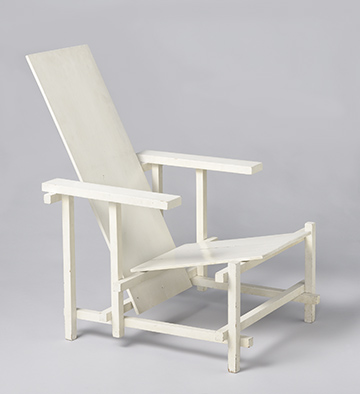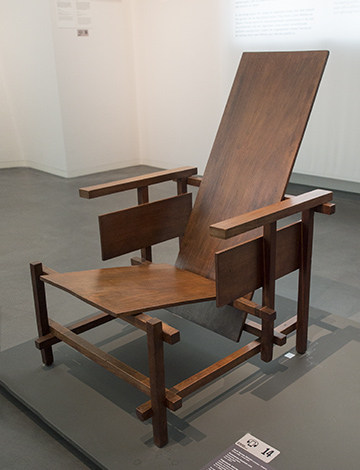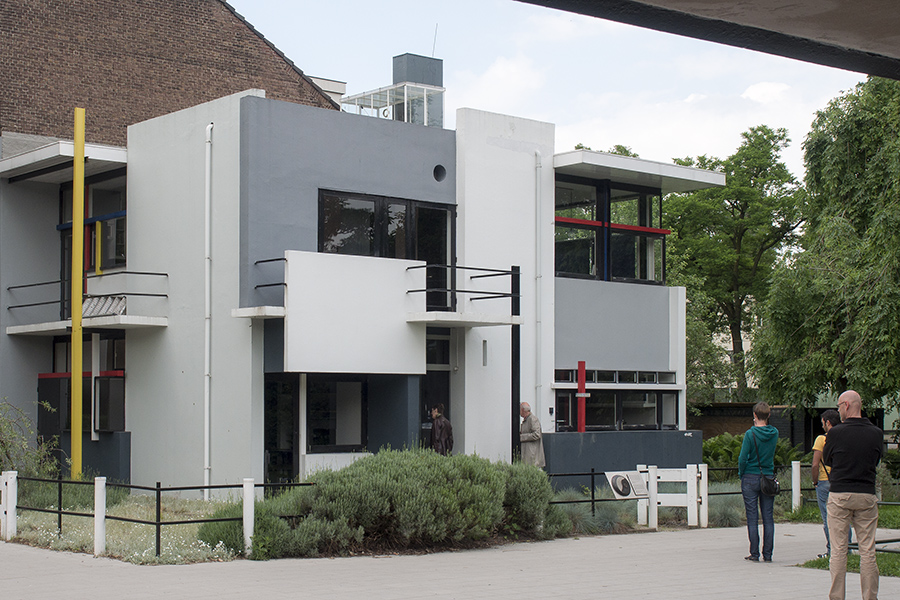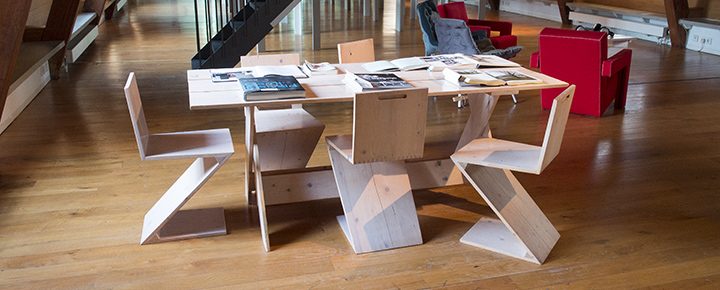
When someone has designed dozens of chairs one can hardly speak of the Rietveld chair. And yet everyone immediately knows which chair you’re talking about when you call it that: the Red and Blue Chair he designed between 1918 and 1923. This is not only his most famous design, it has become iconic for the De Stijl art movement.
Motorway
The Schröder-Rietveld House, however special, found no followers. It was probably too eccentric. Everybody thought it was remarkable but it wasn’t really popular at the time. In 1942 the town council decided to build an raised four-lane motorway right in front of the house, blocking the view towards the fields completely. Rietveld was furious: the house’s free view over the fields was essential to its design; take it away and the design would lose all meaning. For all he cared they might as well tear the house down now. Fortunately, they did not. The couple lived there until Rietveld’s death in 1964; and Truus Schröder stayed until she too died, in 1985. The house was then restored to its original design. The view, regrettably, could not be restored.




Gerrit Rietveld:
Witte leunstoel (white chair), (1923)
collection Rijksmuseum Amsterdam
photo courtesy Rijksmuseum Amsterdam
c/o Pictoright Amsterdam 2013
Truus Schröder was a wealthy indoor architect. In 1921 she hired Rietveld to redecorate a room in her Utrecht mansion. Apparently, she liked the design. And she and Rietveld got on remarkably well on a personal level too. After her husband died in 1923, Rietveld helped Schröder look for a house for her and her children. When they could not find anything satisfactory, he suggested building a completely new house. But the widow Schröder was not easy to please; she turned down his first design. In the end, the house they built was a collaborative effort of two creative spirits.
At the time nobody will have expected that it would one day be Unesco listed, as it was in 2000. But the Schröder-Rietveld House, entirely based on the design principles of De Stijl, became an icon of the Nieuwe Bouwen (New Architecture) movement in The Netherlands.
Zigzagstoel
It is for this house that Rietveld designed the Zig-Zag Chair in 1932. It too became an iconic design, even though its fame only really spread many years after the War. The Zig-Zag Chair can now be bought in design shops all across the world.
Rietveld-Schröderhuis
(1923)



Rood-blauwe leunstoel
(Red and Blue Chair), (1918)
Collection Gemeeentemuseum Den Haag
c/o Pictoright Amsterdam 2013
Gerrit Rietveld:
Zigzagstoel in rood
(Red Zig Zag chair), (1932)
col: Centraal Museum Utrecht
c/o Pictoright Amsterdam 2013
In 1923 the originally Hungarian artist Vilmos Huszár designed a music room for the home of poetess Til Brugman, intended for her friend Sienna Masthoff. Huszár, one of the founding fathers of De Stijl, created a design that might be called a composition in black, grey and white. He really wanted a chair by Rietveld but it would have to be in the right colours. Rietveld was happy to oblige and painted one of his chairs white. (This chair is now in the collection of the Rijksmuseum Amsterdam.)
And Van 't Hoff was right. Editor-in-chief Theo van Doesburg was enthusiastic about Rietveld’s work and presented it in the magazine. The first of Rietveld’s designs published there was a baby chair, followed by a precursor of the Red and Blue Chair.
Ongekleurde lattenleunstoel
(Uncoloured Slat Armchair), (1918 - 1919)
collection Centraal Museum Utrecht
c/o Pictoright Amsterdam 2013

Tabel and Zig Zag Chairs (1932)
in Centraal Museum Utrecht, c/o Pictoright Amsterdam 2013
Unlike some artists, Gerrit Rietveld was not born with a silver spoon in his mouth. From a modest background, he did not have the means to continue his education after primary school. So he went to work in his father’s furniture workshop in Utrecht. We do not know whether he liked his work there or not, but what we do know is that he disliked the traditional designs of the furniture his father made.
Rietveld’s passion and talent for drawing showed at an early age. If the workshop allowed him just a minute, he would be found in a corner, drawing.
Gerrit Rietveld (1888 – 1964)
and his famous chairs
